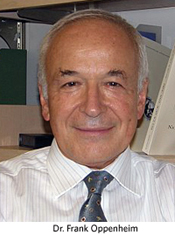Can Whole Saliva Serve as a Diagnostic Medium for Systemic Disease? GSDM's Frank Oppenheim Investigates
In the last ten years there has been a surge of interest in using human whole saliva samples for diagnostics and disease monitoring as an alternative to blood samples. Henry M. Goldman Distinguished Scientist Dr. Frank Oppenheim can understand why there is interest, since collection of saliva can be much less invasive to the patient than collection of blood samples, however he cautions against its use until more is known about how the biomarkers necessary for diagnostics react to proteolytic activity.
Dr. Oppenheim explains that the difference between whole saliva and blood is that blood reflects infection all over the body because it flows. Saliva does not flow; it is secreted in the mouth, where it mixes with gingival fluids and bacteria. So if the biomarkers related to infection in, for example, the heart or the finger did in fact show up in whole saliva, they may be broken down by proteolytic activity in the mouth, to a level where they would be unrecognizable.
His paper, “Whole-saliva Proteolysis and Its Impact on Salivary Diagnostics,” was published in the November 2011 issue of the Journal of Dental Research. The research detailed in the paper can be considered a first step for those interested in testing the viability of whole saliva as a diagnostic medium.
In the paper he describes how various methods of handling and storage of whole saliva samples were examined in order to find the best method, which would preserve the integrity of potential biomarkers. Some of the methods tested were use of heat, extreme PH levels, putting the samples on ice, completely freezing them, and adding proteolytic inhibitors. Of all the methods, short-term storage of freshly collected samples on ice was found to be the best. The ice reduced enzymatic activity and did not interfere with the chemistry of the proteome.
“The paper is a fundamental investigation of the characteristics of whole saliva which will need to be taken into account if valid studies using saliva as a diagnostic medium are carried out,” said Dr. Oppenheim. “If everything gets destroyed by virtue of how the samples are handled we are very likely to come to wrong conclusions.”
“Congratulations to Dr. Oppenheim for having his research selected for publication by the Journal of Dental Research,” said Dean Jeffrey W. Hutter. “This is yet another example of his innovative research and I know the findings of this paper will be used as a resource by countless others.”
The paper is available in full online.